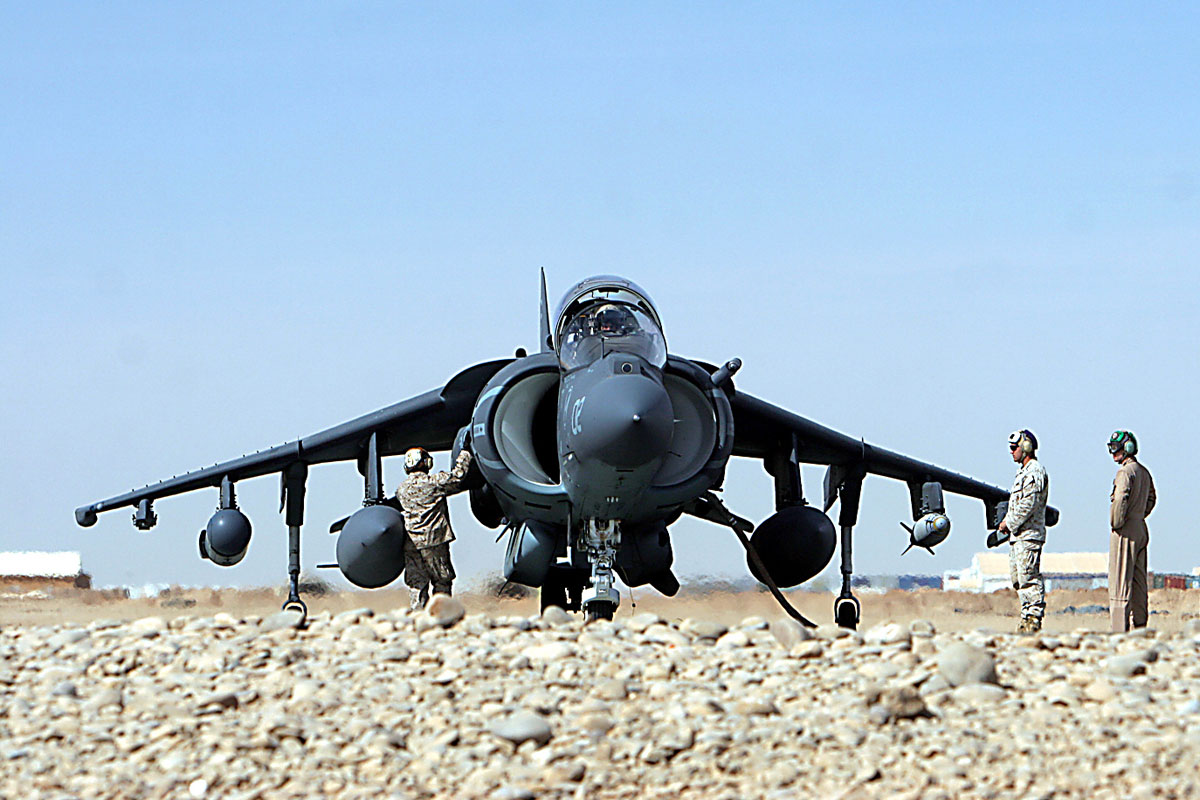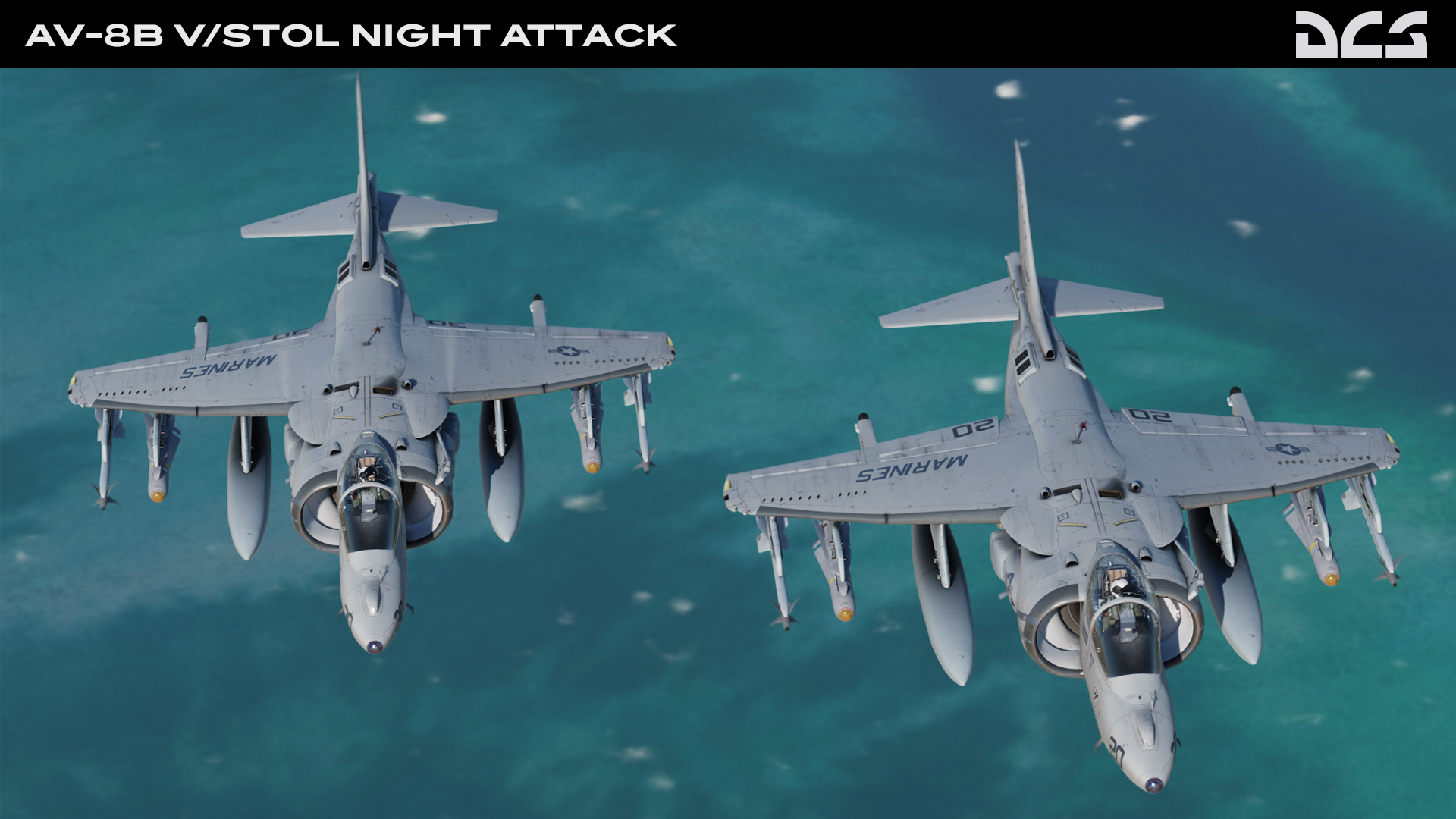Av8b Aircraft - Service: USMC Propulsion: Rolls Royce Pegasus F402-RR-406 turbofan gun Armament: GAU-12 25mm gun; 4x LAU-5003 missile pods; 4x AIM-9 Sidewinders; 6x AIM-120 AMRAAM; 6x AGM-65 Maverick; 2x AGM-84 Harpoons; 2x AGM-88 NOX; Score 80 balls; Paveway laser led bombs; Direct Attacks Simulation Combination Speed: 550 kts. Range: 900 nm
The AV-8B Harrier II is the only short takeoff, vertical launch jet in the current US inventory. Originally flown in the late 1960s, it has undergone several improvements that have increased safety, range and lethality. The AV-8B is a key element of the Marine Corps' "all STOVL force" concept, which allows Marines to sustain operations under harsh conditions in an expeditionary environment.
Av8b Aircraft
22,000 pounds of thrust allows the Harrier II to fly like a helicopter and forward like a jet at near supersonic speeds. Like all naval aircraft, this aircraft is used for several missions that include attacking and destroying surface and air targets, pursuing helicopters, engaging in air defense, reconnaissance and providing offensive and defensive support with armament. missiles, bombs and built in 25mm cannon. Offering the versatility to accomplish almost any mission, the Harrier II provides an ideal blend of firepower and mobility to effectively engage our enemies in place of force.
Av 8b Harrier Ii Retirement Is Stretched To 2030
The AV-8B V/STOL strike aircraft was developed to replace the AV-8A and A-4M light attack aircraft. Marine Corps requirements for V/STOL light attack forces have been well established since the late 1950s. Combining tactical mobility, agility, reduced operating costs, and floating and shore-based flexibility, V/STOL aircraft are uniquely suited to the unique combat and mission requirements of the Marine Corps. The AV-8BII+ is equipped with the APG-65 radar, common with the F/A-18, and all the previous systems and functions common to the AV-8BII.
Ukraine's self-propelled artillery forces have been removed in an attempt to push Russian forces away from the country's second largest country.
Real life Top Gun pilots take to the skies in F-35 fighters. They are like most...
Ukrainian soldiers used American M777 howitzers on the battlefield, trying to repel Russian forces.
Av 8b Harrier Ii Units Of Operation Iraqi Freedom I Vi (combat Aircraft)
A Marine Corps aircraft crashed in Southern California, and civilians and emergency crews responded…
Satellite images released Friday from Snake Island in Ukraine appeared to show a group of sunken Russian ships.
US to send 31 M1 Abrams tanks to Ukraine, despite concerns President Biden's announcement comes in the wake of months of persistent arguments that tanks are too difficult for Ukrainian forces to...

Germany Releases Leopard Tanks to Ukraine After US Offer The German government has confirmed that it will provide Ukraine with the Leopard 2 war-fighting tanks and other approvals.
Th Aircraft Squadron (av 8b 'harrier')
On the other hand, the US has approved the Abrams tank for Ukraine. The US is expected to announce, according to Germany's announcement, that Poland will approve the request...
Take a look at the Leopard 2 tanks that could soon be sent to Ukraine. Krauss-Maffei Wegmann of Germany, the maker of the Leopard 2, touts it as "the world's leading warship."
The US and its allies arm Ukraine with weapons and armor ahead of the looming Russian threat " redirect here For first generation aircraft used by the US Marine Corps such as the AV-8A and AV-8C, see Hawker Siddeley Harrier.
The McDonnell Douglas (now Boeing) AV-8B Harrier II is a single-engine attack aircraft, the second generation of the Harrier family, capable of vertical or short take-off and landing (V/STOL). The aircraft are mainly used in light attack or in multi-part missions from close air support to armed reconnaissance of local areas. The AV-8B is used by the United States Marine Corps (USMC), the Spanish Navy and the Italian Navy. A variation of the AV-8B, the British Aerospace Harrier II, was developed by the British military, while the other, the TAV-8B, was dedicated to the military headquarters.
Aircraft Av 8b Harrier Ii British Aerospace Sea Harrier Airplane Canva
The project that eventually led to the AV-8B began in the early 1970s as a joint effort between the United States and the United Kingdom to address the performance deficiencies of the first generation Hawker Siddeley Harrier. Initial attempts were made with a larger and more powerful Pegasus genie to greatly improve Harry's abilities. Due to budget constraints, the UK project was abandoned in 1975. After the withdrawal of the UK, McDonnell Douglas extensively modified the previous AV-8A Harrier to create the AV-8B. Retaining the general layout of its predecessor, the aircraft included a new and larger composite wing with additional hard on each side, a raised cockpit, a tapered fuselage and other structural and aerodynamic improvements. The Pegasus version was considered better. It flew as an AV-8B slave in November 1981 and entered service with the USMC in January 1985. Later upgrades added night attack capability and radar, resulting in the AV-8B(NA) and AV-8B Harrier II Plus versions respectively. A larger version called the Harrier III was also studied but not pursued. The UK, through British Aerospace, announced the development of the Harrier in 1981, making it a significant part of the effort. Following the merger in 1990, Boeing and BAE Systems jointly supported the program. Approximately 340 aircraft were made during the 22-year production program, which ended in 2003.
Typically operated from small aircraft carriers, large amphibious assault ships, and simple forward-based bases, the AV-8Bs shared many military and humanitarian missions, proving their versatility. US Army General Norman Schwarzkopf named the USMC Harrier II as one of the most important weapons in the Gulf War. It has also been used in Afghanistan since 2001, in the Iraq War since 2003, and in Operation Odyssey Dawn in Libya in 2011. Italian and Spanish Harrier II ships have participated in overseas conflicts with NATO coalitions. In its service history, the AV-8B has had a high accident rate compared to the time spent on critical takeoff and approach times. The USMC and Italian Navy AV-8Bs are being replaced by the Lockheed Martin F-35B Lightning II, which is expected to enter service with its Harriers by 2025.
In the late 1960s and early 1970s, the first generation of Harriers served the Royal Air Force (RAF) and the USMC, but were hampered by squadrons and funding. In its short takeoff and landing configuration, the AV-8A (American designation Harrier) carried less than half the 4,000 lb (1,800 kg) payload of the smaller A-4 Skyhawk over a narrower radius.

To solve this, Hawker Siddeley and McDonnell Douglas began joint development of a superior version of the Harrier in 1973. The first efforts focused on an improved Pegasus foot, designated the Pegasus 15, tested by Bristol Siddeley.
U.s. Marines Conduct An Environmental Control System Test On An Av 8b Harrier Aircraft On Camp
Although more powerful, the 2.75 inch (70 mm) diameter was too large for the Harrier to fit easily.
In December 1973, a joint American-British company completed a design document to improve the Harrier with the Pegasus 15 engine. The upgraded Harrier was intended to replace the original RAF and USMC Harriers, as well as the USMC A-4 Skyhawk.
The improved Harrier was intended to double the payload and range of the AV-8 and was therefore privately designated the AV-16. The British plan was withdrawn in March 1975 due to budget cuts, rising costs and a shortage of 60 aircraft for the RAF.
Despite the target's goal, the two teams each set a track for the Harrier. Hawker Siddeley aimed for a new, larger wing that could backfire on existing operational aircraft, while McDonnell Douglas insisted on a less ambitious, though still large, wing that met the needs of the US military. Using knowledge gained from the AV-16 effort, although dropping some like the larger Pegasus, McDonnell Douglas retained the basic structure and engine of the USMC custom aircraft.
Blacksheep Retire Av 8b Harrier Ii Aircraft
Because the USMC wanted to significantly improve the Harrier without developing a new gen, the Harrier II development plan was approved by the United States Department of Defse (DoD) in 1976.
The United States Navy (USN), which had traditionally acquired military aircraft from the USMC, said the new design would be tested through flight tests.
McDonnell Douglas modified two AV-8s with new wings, revised fuselage, redesigned exhaust nozzles, and other aerodynamic changes; The modified front fuselage and cockpit found on all rear aircraft were not included in these prototypes.

Designated YAV-8B, the first modification of the aircraft flew on November 9, 1978. The plane made three vertical takeoffs and flew seven minutes between Lambert-St. Louis International Airport.
Dc Designs Releases Av 8b Harrier Ii
A second aircraft followed on February 19, 1979, but crashed in November due to trap flames; the pilot ejected safely.
The event drew more than expected, hindering the high speed of the aircraft. Subsequent improvements to the airfoil were made with minor improvements.
Positive test results in other areas, including payload, range and V/STOL performance, led to the award of a development contract in 1979. Initially, a contract was provided for the purchase of 12 aircraft, then another 324 aircraft.
The YAV-8B is converted from the AV-8A and so no
Marine Corps Av 8b Harrier Crashes Outside Mcas Cherry Point; Pilot Safely Ejected
Av-8b harrier model, av 8b night attack, 1 48 av 8b, av-8b harrier, av 8b plus, usmc av 8b, hobby master av 8b, av 8b ejection seat, av 8b, av 8b harrier assault, av 8b engine, av 8b harrier cockpit
0 Comments